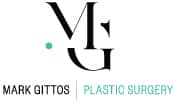Breast Implant Position: Above vs Below the Muscle
Two of the most popular breast implant positions are submuscular (under or behind the muscle) and subglandular (above or in front of the muscle). So, what are the differences between the two implant placements?
Above-the-muscle implants are more suitable for patients with substantial natural breast tissue who might want to get large breast implants. At the same time, below the muscle implants might be a better option for patients who don’t have enough natural breast tissue or who don’t want a significant increase in breast size.
Patients who opt for subglandular breast implants can benefit from a better cleavage outline, bigger implants, less risk of animation deformity, and a faster healing period. Alternatively, submuscular implants can provide a lower risk of capsular contracture, lower risk of infection, less mammography interference, and more natural results.
Dr Mark Gittos is one of the top plastic surgeons in Australia. He has profound knowledge of breast anatomy and immense skill in performing different breast augmentation surgeries. Dr Gittos can professionally guide you toward the best implant placement choice that can give you the most natural and long-lasting results.
Download Dr Mark Gittos’ Guide to Cosmetic Breast Surgery
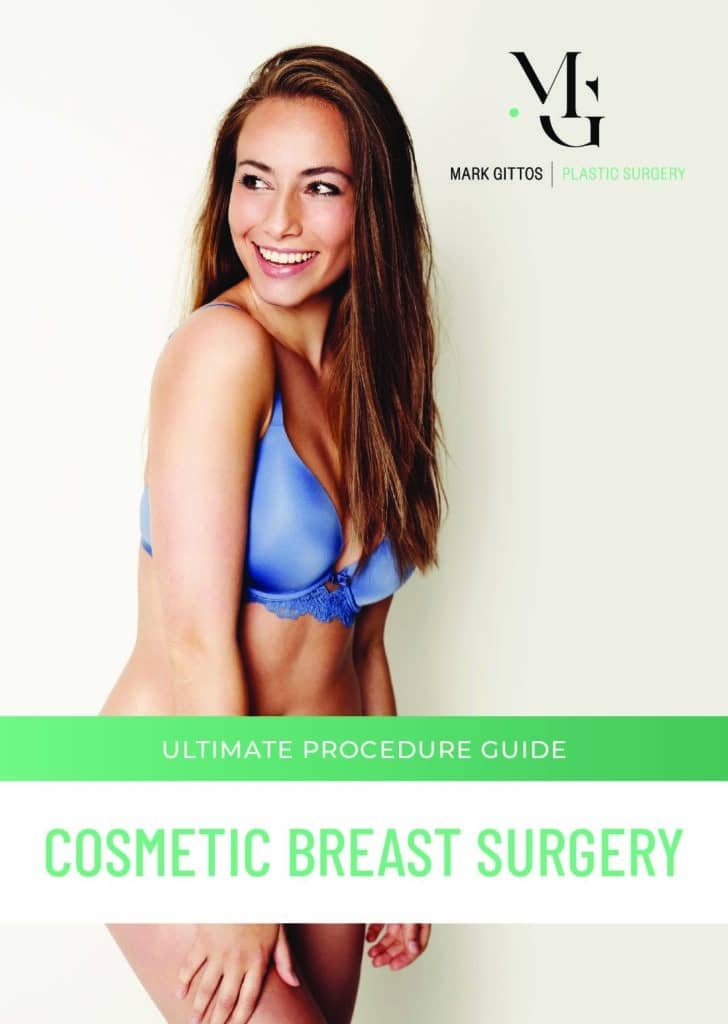
Simplified Breast Anatomy
Understanding the anatomy of your breasts can help you get an idea about how the breast implants may be positioned during your surgery.
The breast is made up of 3 main types of tissue:
- Glandular tissue: contains the glands and ducts responsible for producing and transporting breast milk
- Fat tissue: the fat or adipose tissue gives the breast its volume
- Connective tissue: surrounds and holds everything together and gives the breast its shape and firmness
Moreover, your breasts lay on top of the chest wall muscles, also known as the pectoral muscles.
Different Positions for Breast Implants
Before your breast implant surgery, Dr Mark Gittos will discuss the different options for implant placement. Then, together, you’ll decide what the best breast implant location for you is.
The location of your breast implant can be under the glandular tissue (subglandular) or under the pectoral muscle (submuscular).
1. Subglandular breast implants
Subglandular, prepectoral, or over-the-muscle breast implants are placed beneath your glandular tissue and on top of your chest muscles. In this position, the implant would be supported by your pectoral muscles and covered by your fatty breast tissue and your breast skin.
During breast augmentation surgery using subglandular implants, your pectoral chest muscles will be left in place; Dr Gittos doesn’t have to cut through them or move them to place your implant.
Dr Mark Gittos usually recommends over-the-muscle breast implants for women with a fair amount of natural breast tissue that can give the implant good coverage. Placing the implants above the chest muscles instead of under them, gives Dr Gittos more room to place larger implants during breast surgery.
2. Submuscular breast implants
In certain cases, a submuscular implant placement might be preferred to a subglandular position.
Submuscular breast implants are inserted deeper under the chest muscle. In this placement, the implant will be covered by both your pectoral muscle and your glandular breast tissue.
Unlike with the subglandular breast implant, the placement of an implant under the muscle involves the cutting and manipulation of your chest muscles. The pectoral muscle is pulled forward to create a pocket so that the implant can be inserted beneath the muscle.
Dr Gittos may recommend under-the-muscle breast implants instead of subglandular implants for women who don’t have substantial natural breast tissue and aren’t looking to get very large implants.
What Are The Benefits of Each Breast Implant Position?
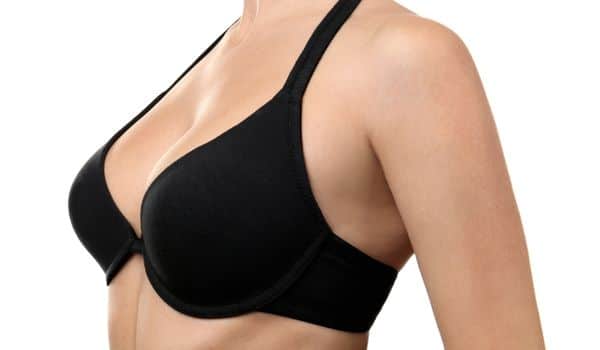
Each breast implant placement can offer certain benefits to different patients. Before diving into the advantages of different breast implant positions, find out which one might be suitable for you.
You might be a good candidate for subglandular breast implants in case:
- You have a fair amount of natural breast tissue
- You want to keep your chest wall muscles undisturbed (you’re an athlete or planning on breastfeeding in the future)
On the other hand, you may be a suitable candidate for submuscular breast implants if:
- You’re slim and/or don’t have substantial natural breast tissue
- You’re a breast cancer survivor and/or have previously had extensive breast resection
- You don’t want very large implants
- You’re not planning on breastfeeding in the future
Above-the-muscle Breast Implant Advantages
- Bigger implants: your skin and glandular tissue have more room to stretch than your chest wall muscles. Therefore, you can get a larger breast size with subglandular implants than with submuscular ones
- Less invasive approach: the chest muscles are left in place and intact when the implant is placed on top of the chest muscle instead of beneath it. This makes the over-the-muscle placement less invasive than the under-the-muscle placement. As a result, you’ll feel less pain and be able to heal faster with a subglandular breast implant than you would with a submuscular breast
- Lower risk of distortion or animation deformity: when the implant is positioned beneath the pectoral muscle, it can move when the muscle contracts. Your breasts will be less likely to show distortion or animation deformity when you flex your chest muscles when the implant is on top of your muscle rather than under it
- Better cleavage outline: since a subglandular implant is covered by flexible fatty breast tissue and not a rigid chest muscle, it will be able to produce a more pronounced cleavage than a submuscular implant
- You’ll still be able to breastfeed: implants under the glands are more likely to leave your breast milk glands and ducts intact. Therefore, you’ll be more likely able to breastfeed after your breast augmentation surgery
Below-muscle Breast Implant Advantages
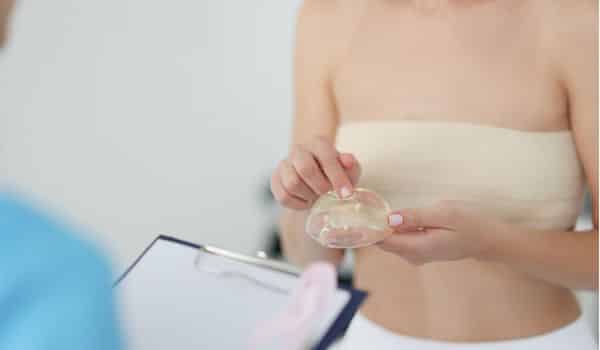
- Lower risk of capsular contracture: breast scar tissue may sometimes form a capsule around the breast implant and become tightened. This tightened capsule of scar tissue is known as capsular contracture. When the implant is placed under the muscle instead of above it, the muscle forms a barrier between the implant and the breast’s soft tissue. This makes it less likely for the breast tissue to harden and form contracted capsules
- Lower risk of infection: submuscular implant placement is considered the most breast augmentation technique. The more sterile the surgical approach is, the less likely you’ll have an infection after breast surgery
- Better mammography results: unlike subglandular implants, submuscular ones will be placed under the breast (behind the muscle) and shouldn’t interfere with the quality of your mammogram images
- Better nipple sensation: Dr Gittos doesn’t have to dissect your breast tissue to place the implant beneath your chest muscle. Hence, the chances are that your nipple’s blood supply and nerve endings will remain intact and you are more likely be able to maintain nipple sensation after your breast surgery
- More natural-looking results: the implant will be well hidden under your chest muscle so it would be less apparent. This below-the-muscle implant placement can give your breasts a smooth breast slope and a more natural breast look. It can also make your breast feel better to touch because the implant will not be right under the breast tissue but covered up by the chest muscle as well
Which Breast Implant Position Should I Get?
The choice to get a submuscular or a subglandular breast implant is a highly personal one. It’s not just about what suits your body anatomy, it’s also about what suits your aesthetic goals and what breasts you want to end up with.
Patients who are more concerned with their ability to breastfeed after getting a breast implant may go for above-the-muscle implants instead of below-the-muscle implants. Alternatively, patients who want their breasts to look and feel more natural might prefer submuscular implants over subglandular ones.
Moreover, if you want significantly bigger breasts with an enhanced cleavage outline, getting implants on top of the muscle might be a better option for you than getting them beneath your chest muscles. Meanwhile, if you don’t want your breast implants to compromise your future mammogram results, you might want to get submuscular implants rather than subglandular ones.
Additionally, patients who prefer a shorter recovery time after their breast implant surgery are more likely to heal quicker and return to normal activity faster with subglandular implant placement than with under the muscle implant placement.
With that said, around two-thirds of Dr Gittos’ patients choose to go with above-the-muscle implants while fewer opt for below-the-muscle implants.
As mentioned above, each position of breast implant has its advantages and benefits. Dr Mark Gittos will thoroughly go through each implant placement option with you. He will help you understand the advantages and possible disadvantages of different breast implant positions. He will also discuss your aesthetic goals and needs in detail to help you decide what the best implant position for you is.
FAQs about Breast Implant Position
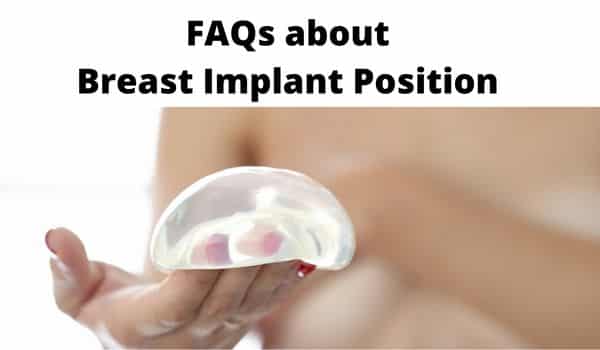
What are the disadvantages of subglandular breast implants?
- Despite their many advantages, above-the-muscle breast implants may have a few drawbacks. Since the breast implant will be directly in contact with your glandular breast tissue, subglandular implants carry a higher risk of capsular contracture (the soft tissue around the implant contracts and becomes thick). Moreover, a subglandular implant will only be covered by soft tissue which can make it more visible and can cause rippling on the surface of the breasts when you move. Implants placed above your chest muscle can also get in the way of your mammogram screenings making them more difficult to interpret.
What are the disadvantages of submuscular breast implants?
- The size of the breast implant can be limited if the implant is placed behind the muscle, which cannot stretch too much. So you may not be able to make your breasts substantially bigger. Moreover, below the muscle implants require the manipulation of the chest muscle, At the same time, your recovery period may be a bit longer with a submuscular implant than with a subglandular implant.
Can breast implants be combined with fat grafting?
- Composite breast augmentation, also known as hybrid breast augmentation, combines subglandular implants with autologous fat (fat from your own body) injections into the breast. The additional grafted fat can further improve your breast’s contour and emphasise your cleavage.
Do implants feel the same as natural breasts?
- How your breasts feel after you get an implant will depend on both the placement and type of implant. Below the muscle breast implants usually feel more natural to the touch than subglandular implants. On the other hand, there are certain types of breast implants, such as the “gummy bear” breast implants, that can mimic the feel of natural breast tissue even when they’re placed in a subglandular position.
Will my implants look bigger if I lose weight?
- Since your implants are not a natural part of your body, their size will stay the same whether you gain or lose weight. In case you lose significant weight, your breasts might appear bigger. Therefore, it’s important to maintain healthy body weight without a lot of fluctuations following your breast augmentation surgery to make sure you get the best aesthetic results for as long as possible.
Read about Breast Augmentation Surgery with Dr Gittos
Medical References about Breast Implant Position
- Breast Augmentation – StatPearls – NCBI Bookshelf
- Complete submuscular breast augmentation: 650 cases managed using an alternative surgical technique
- Results of subglandular versus subpectoral augmentation over time: one surgeon’s observations
About Dr Mark Gittos FRACS (Plast) – New Zealand Plastic Surgeon
Practice locations in Herne Bay Auckland, Northland and Bay of Plenty – Kerikeri, Whangarei, New Plymouth & Tauranga
Dr Mark Gittos is a leading Specialist Plastic Surgeon and operates a practice in Herne Bay, Auckland and in the UK. The practice focuses on both surgical and non-surgical procedures, each designed to help restore, improve or change a physical characteristic or problem. The first step in every case is to talk through your personal requirements and explore all the options, before deciding on the most effective solution.
Dr Mark Gittos offers high quality, natural-looking cosmetic surgery results and is highly experienced in Breast, Body and Face Surgery having performed over 4000 Surgeries in the last 26 years. With worldwide expertise Dr Gittos is an expert in breast, face and body surgery for men & women.
Naturally, before any treatment is begun, we will explain clearly the advantages and risk factors; so that you have the information you need to make an informed decision that is best for you. Visit the practice to find out more.

NEXT STEPS
Please NOTE: Dr Gittos only performs surgery on non-smoker patients with a BMI less than 30. To check your BMI please visit the NZ Heart Foundation website. For help giving up smoking before surgery visit the Smoke Free website
Do your Research
- Read the Website and Blogs relevant to your procedure
- Browse our Frequently Asked Questions including how to choose a Surgeon for your procedure
- Download and read the FREE Guides to Surgery
What to Bring to your Plastic Surgeon Consultation
- Bring a friend or relative to help discuss the information and your choices
- Take lots of notes and read the documents provided thoroughly
- Dress in simple clothes as you may need to undress for examination
- Bring your medical referral and any relevant medical documents or test results
Book your Initial Surgery Consultation
- A Referral from your GP or specialist is helpful but NOT essential – you can have a consultation without a GP Referral
- Email us or Call on 09 529 5352 to arrange your surgeon consultation appointment.
- Book a consultation with Dr Gittos by paying the Consultation Fee – $325 incl GST
Traveling for Surgery? – Consider post-surgery luxury recovery in a Hotel with LuxeCare
Please contact us to arrange to book a consultation with our Specialist Plastic Surgeon or to speak with our Patient Care Advisor.
Send an enquiry form today or phone 09 529 5352 during Clinic Hours.
